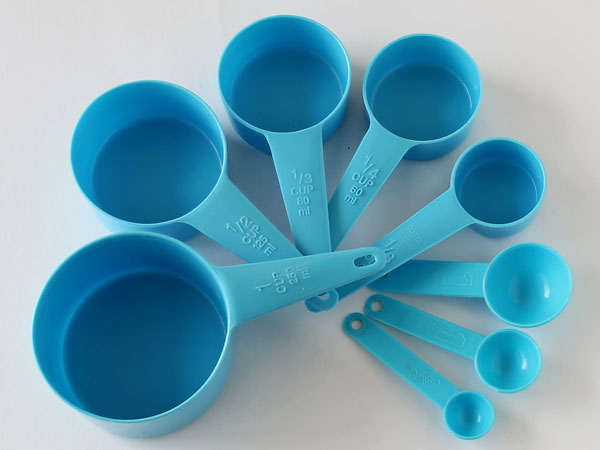All cooking ingredients are measured with Metric style measuring cup set (1 cup = 250 ml ) size in all recipes on this website.

Measuring cup set is an important utensil to have in the kitchen and it is always recommended to use it for all new recipes that you are trying. To get the best cooking results for recipes specified on our website, it’s necessary to measure all ingredients with metric style measuring cups and spoons and have them placed in the order of use (typically in the order of ingredients specified in the table) before starting on the directions. This will make cooking easier, reduce the chances of forgetting to add/use key ingredients and most importantly, loosing critical time in finding the ingredient while cooking process is already underway and recipe demands adding next ingredient at very specific stage and not over cooking.
Common Conversions from Cups to Tablespoon and Teaspoon
You can see the different types of spoons and cups in the photo given above. The typical cooking measuring cup sizes are 1 cup, 1/2 cup, 1/3 cup, 1/4 cup and 1/8 cup. The typical spoon sizes are 1 tablespoon, 1/2 tablespoon, 1 teaspoon, 1/2 teaspoon and 1/4 teaspoon. The jug (large container with measurement indication) is generally used for measuring liquid ingredient in large quantities. Sometimes, it’s easy to misplace parts of measure sets and following conversion information will help you derive the correct size.
| 1 cup | 16 Tablespoon |
| 1/2 cup | 8 Tablespoon |
| 1/4 cup | 4 Tablespoon |
| 1/8 cup | 2 Tablespoon |
| 1 Tablespoon | 3 Teaspoon |
| 1/2 Tablespoon | 1.5 Teaspoon |
| 1 Pinch | 1/8 Teaspoon |
How to Measure Dry Ingredients?
To measure dry ingredients like flours, sugar, semolina, spices powder, etc., fill the measuring cup or measuring spoon with the ingredient up to brim and then level it with back edge of a knife or a spatula.
Many dry ingredients, such as granulated sugar, are not very compressible, so volume measures are consistent. However others, notably flour, are more variable. For example, 1 cup of all-purpose flour sifted into a cup and leveled with technique mentioned above weighs about 100 grams, whereas 1 cup of all-purpose flour scooped from its container and leveled weighs about 140 grams. Wherever required, our recipes also mention to use compressed or uncompressed quantities.
Using a measuring cup to measure bulk foods, which can be compressed to a variable degree such as chopped vegetables or shredded cheese leads to large measurement uncertainties and it is recommended to chop the vegetables and fruits into pieces for a correct measure.
To measure dry ingredients like flours, sugar, semolina, spices powder, etc., fill the measuring cup or measuring spoon with the ingredient up to brim and then level it with back edge of a knife or a spatula.
Many dry ingredients, such as granulated sugar, are not very compressible, so volume measures are consistent. However others, notably flour, are more variable. For example, 1 cup of all-purpose flour sifted into a cup and leveled with technique mentioned above weighs about 100 grams, whereas 1 cup of all-purpose flour scooped from its container and leveled weighs about 140 grams. Wherever required, our recipes also mention to use compressed or uncompressed quantities.
Using a measuring cup to measure bulk foods, which can be compressed to a variable degree such as chopped vegetables or shredded cheese leads to large measurement uncertainties and it is recommended to chop the vegetables and fruits into pieces for a correct measure.
| Name | 1 cup Equals | 1/2 cup Equals |
| Whole Wheat Flour | 120 gm | 60 gm |
| Maida (all purpose flour) | 120 gm | 60 gm |
| Gram Flour (besan) | 100 gm | 50 gm |
| Semolina | 200 gm | 100 gm |
| Raw Rice (uncooked) | 200 gm | 100 gm |
| Lentils (dals) | 200 gm | 100 gm |
| Granulated Sugar | 200 gm | 100 gm |
| Powdered Sugar | 120 gm | 60 gm |
How to Measure Liquid Ingredients?
To measure liquid ingredients specified in quantity higher than a cup, place a measuring jug (large cup) on flat surface, pour the liquid in it and check it at eye level to measure. To measure liquid ingredients specified in quantity smaller than cup, use tablespoons, teaspoons and smaller cups (1/2 cup, 1/4 cup, 1/3 cup).
To measure liquid ingredients specified in quantity higher than a cup, place a measuring jug (large cup) on flat surface, pour the liquid in it and check it at eye level to measure. To measure liquid ingredients specified in quantity smaller than cup, use tablespoons, teaspoons and smaller cups (1/2 cup, 1/4 cup, 1/3 cup).
| 1 cup | 250 ml |
| 3/4 cup | 188 ml |
| 2/3 cup | 165 ml |
| 1/2 cup | 125 ml |
| 1/3 cup | 83 ml |
| 1/4 cup | 60 ml |
| 1/8 cup | 30 ml |
| 1 tablespoon | 15 ml |
| 1/2 tablespoon | 7.5 ml |
| 1 teaspoon | 5 ml |
| 1/2 teaspoon | 2.5 ml |
Where to Buy Measuring Cup Sets?
You can easily buy measuring cup sets and spoons from local utensil store or from online store.
You can easily buy measuring cup sets and spoons from local utensil store or from online store.